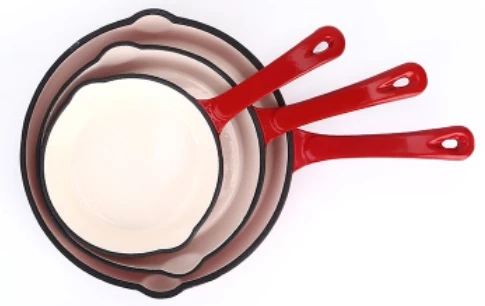የካቲ . 03, 2025 01:50
Back to list
season a new cast iron skillet
The journey of seasoning a new cast iron skillet is both a rite of passage and a commitment to culinary excellence, rooted deeply in tradition and science. Having seasoned countless cast iron pieces for over two decades as a culinary enthusiast and cookware expert, I've honed a meticulous process that enhances not only the skillet's performance but also the flavor and texture of the food it lovingly prepares.
The temperature and duration of oil polymerization are crucial. Preheat your oven to 450°F (232°C). Turn the skillet upside down on the center rack of the oven—place a piece of aluminum foil below to catch any potential drips. Bake the skillet for one hour, allowing the oil to reach its smoke point and begin creating the patina. After an hour, turn off the oven and let the skillet cool inside to ensure gradual temperature changes, minimizing stress on the metal. This process should be repeated two to three times to establish a solid seasoning layer before using the skillet for cooking. Each cycle of heating and cooling reinforces the non-stick layer, making it increasingly effective. Once seasoned, maintaining the cast iron skillet’s patina is a continuous but rewarding task. After each use, clean the skillet with hot water and a brush; avoid soap and aggressive scrubbing. For stubborn, stuck-on food, use coarse salt as a scrub before rinsing with hot water. After cleaning, dry the skillet completely. A quick method is heating it on the stove until it just begins to smoke, then removing it from heat. To protect and reinforce the seasoning layer, apply a small amount of oil after each washing, rubbing it into the warm pan until the sheen diminishes. This simple habit preserves the non-stick properties and extends the skillet's lifespan significantly. Understanding and respecting the seasoning process transforms a new cast iron skillet into an essential kitchen ally. Its unrivaled heat retention and enriching contributions to flavors make it indispensable for cooking enthusiasts. Over time, your seasoned cast iron will not only enhance your meals but also stand as a testament to the alliance between culinary craftsmanship and scientific understanding. As you cultivate this tool, remember you’re participating in a culinary tradition that promises durable, delicious, and healthy cooking experiences for generations.


The temperature and duration of oil polymerization are crucial. Preheat your oven to 450°F (232°C). Turn the skillet upside down on the center rack of the oven—place a piece of aluminum foil below to catch any potential drips. Bake the skillet for one hour, allowing the oil to reach its smoke point and begin creating the patina. After an hour, turn off the oven and let the skillet cool inside to ensure gradual temperature changes, minimizing stress on the metal. This process should be repeated two to three times to establish a solid seasoning layer before using the skillet for cooking. Each cycle of heating and cooling reinforces the non-stick layer, making it increasingly effective. Once seasoned, maintaining the cast iron skillet’s patina is a continuous but rewarding task. After each use, clean the skillet with hot water and a brush; avoid soap and aggressive scrubbing. For stubborn, stuck-on food, use coarse salt as a scrub before rinsing with hot water. After cleaning, dry the skillet completely. A quick method is heating it on the stove until it just begins to smoke, then removing it from heat. To protect and reinforce the seasoning layer, apply a small amount of oil after each washing, rubbing it into the warm pan until the sheen diminishes. This simple habit preserves the non-stick properties and extends the skillet's lifespan significantly. Understanding and respecting the seasoning process transforms a new cast iron skillet into an essential kitchen ally. Its unrivaled heat retention and enriching contributions to flavors make it indispensable for cooking enthusiasts. Over time, your seasoned cast iron will not only enhance your meals but also stand as a testament to the alliance between culinary craftsmanship and scientific understanding. As you cultivate this tool, remember you’re participating in a culinary tradition that promises durable, delicious, and healthy cooking experiences for generations.
Next:
Latest news
-
Why Ecast Iron Grills Are Heating Up Outdoor CookingNewsMay.23,2025
-
Why Cast Iron Cookware Belongs in Every Kitchen?NewsMay.23,2025
-
Why Cast Iron Bakeware Is a Timeless Kitchen EssentialNewsMay.23,2025
-
Upgrade Your Kitchen with Cast Iron Bakeware SetsNewsMay.23,2025
-
Master Outdoor Cooking with the Camping Dutch OvenNewsMay.23,2025
-
Casserole Cast Iron Cookware for Rich, Slow-Cooked FlavorNewsMay.23,2025
-
The Ultimate Guide to Cast Iron Deep Dish Pizza PerfectionNewsMay.21,2025
